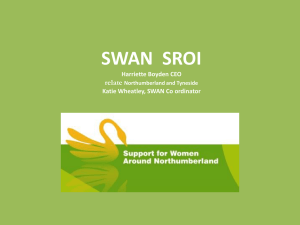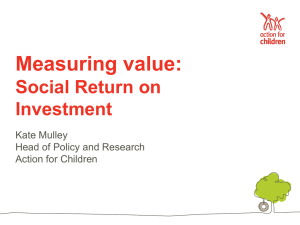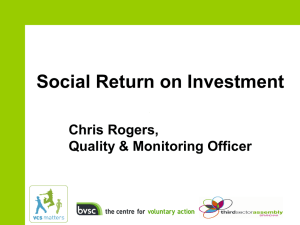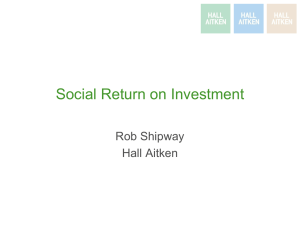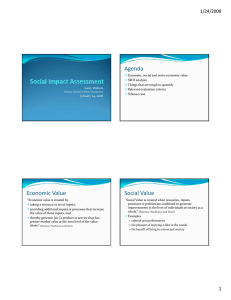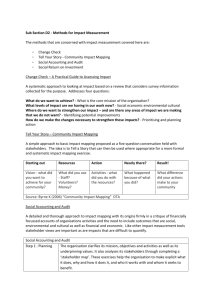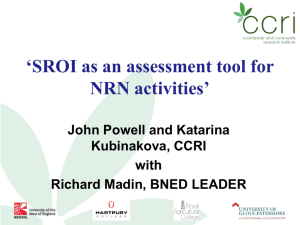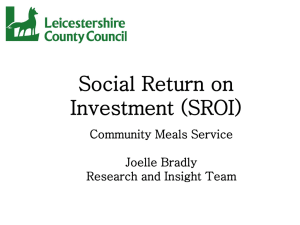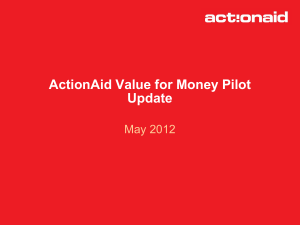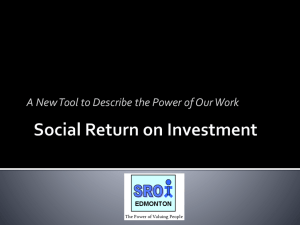(SROI) Template
advertisement
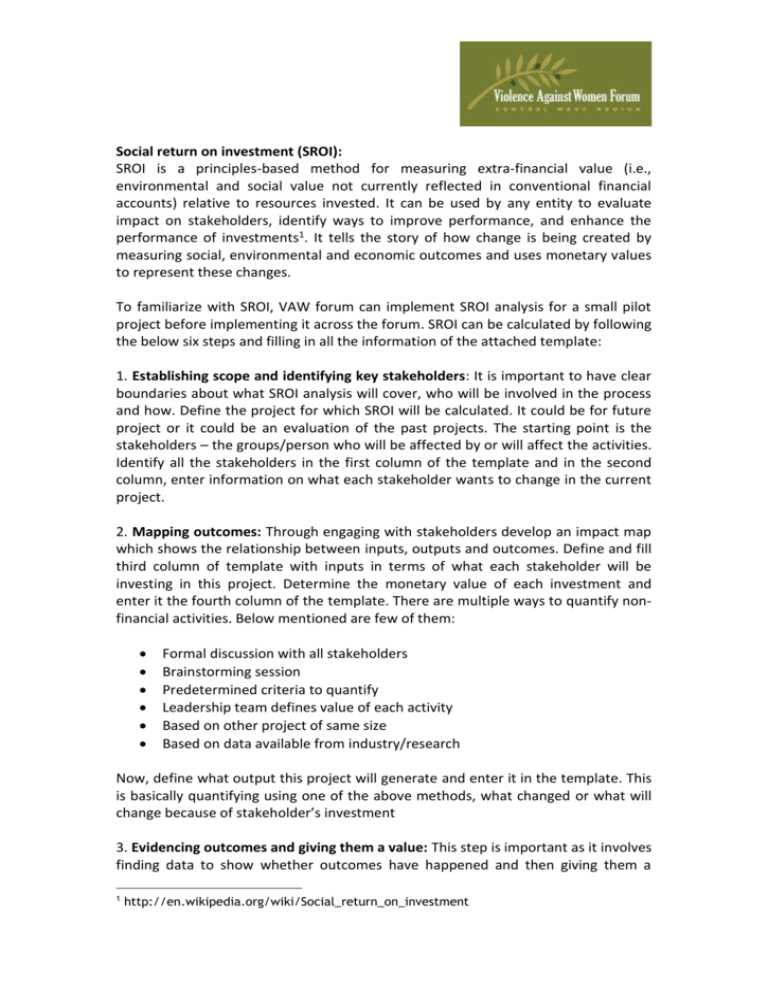
Social return on investment (SROI): SROI is a principles-based method for measuring extra-financial value (i.e., environmental and social value not currently reflected in conventional financial accounts) relative to resources invested. It can be used by any entity to evaluate impact on stakeholders, identify ways to improve performance, and enhance the performance of investments1. It tells the story of how change is being created by measuring social, environmental and economic outcomes and uses monetary values to represent these changes. To familiarize with SROI, VAW forum can implement SROI analysis for a small pilot project before implementing it across the forum. SROI can be calculated by following the below six steps and filling in all the information of the attached template: 1. Establishing scope and identifying key stakeholders: It is important to have clear boundaries about what SROI analysis will cover, who will be involved in the process and how. Define the project for which SROI will be calculated. It could be for future project or it could be an evaluation of the past projects. The starting point is the stakeholders – the groups/person who will be affected by or will affect the activities. Identify all the stakeholders in the first column of the template and in the second column, enter information on what each stakeholder wants to change in the current project. 2. Mapping outcomes: Through engaging with stakeholders develop an impact map which shows the relationship between inputs, outputs and outcomes. Define and fill third column of template with inputs in terms of what each stakeholder will be investing in this project. Determine the monetary value of each investment and enter it the fourth column of the template. There are multiple ways to quantify nonfinancial activities. Below mentioned are few of them: Formal discussion with all stakeholders Brainstorming session Predetermined criteria to quantify Leadership team defines value of each activity Based on other project of same size Based on data available from industry/research Now, define what output this project will generate and enter it in the template. This is basically quantifying using one of the above methods, what changed or what will change because of stakeholder’s investment 3. Evidencing outcomes and giving them a value: This step is important as it involves finding data to show whether outcomes have happened and then giving them a 1 http://en.wikipedia.org/wiki/Social_return_on_investment monetary value. Outcomes are defined based on indicators agreed before. Mention all the indicators in column seven. Now, quantify them in terms of quantity and monetary value. 4. Establishing impact: Those aspects of change that would have happened anyway or are a result of other factors are taken out of the analysis. This step is basically determining rates of deadweight, drop off, displacement, attribution and discount. Once these rates are determined calculate the impact. This can be calculated as quantity multiplied by value less deadweight, attribution and displacement. Now calculate the impact for next few years if calculating SROI for future project. If this is evaluation of project then use historic data of last few years. 5. Calculating the SROI: This stage involves adding up all the benefits, subtracting any negatives and comparing the result with the investment. The SROI index is the total impact (Net present value) for years 1 to 5, divided by the total investment. 6. Reporting: The final step is to report the SROI to all the stakeholders and determine the next steps of project. VAW forum can tweak this template as required. Columns can be added and/or removed based on each project’s requirement. The SROI Template2 Stakeholders Who changes? wants change? Who Intended/ unintended changes Inputs What they want to change What they invest (description) Outputs What they invest (value $ ) (20) Summary activity (quantified) The Outcomes of Description of outcome Indicator Quantity (1) Value(2) The columns of the impact map continue to the right: Deadweight % (3) What would have happened without us? Displacement % (4) Attribution % (5) Drop off % (6) Impact What activity did you displace? Who else contributed to the change? Does the value of the outcome drop off in future years? Outcome: quantity (1) times value(2) less deadweight(3), attribution(5) and displacement (4) Calculating Social Return Discount rate (%) Agreed Discount rate (7) Impact in first year (8)Impact from previous year (7) less drop off (6) (9)Impact from previous year(8) less drop off (6) (10)Impact from previous year(9) less drop off(6) (11)Impact from previous year(10) less drop off(6) Year 1 Year 2 Year 3 Year 4 Year 5 $0.00 $0.00 $0.00 $0.00 $0.00 $0.00 $0.00 $0.00 $0.00 $0.00 $0.00 $0.00 The SROI index is the total impact (Net present value) for years 1 to 5, divided by the total investment (20). 2 SROI - Scottish Investment Fund http://www.google.ca/url?sa=t&rct=j&q=&esrc=s&source=web&cd=1&ved=0CCwQFjAA&url=http%3A%2F%2Fwww.scottishinvestmentfund.co.uk%2FFile%2FSROI_Guidance_for_applicants.doc&ei= pBjKUdy0LMGjyAGPs4D4Ag&usg=AFQjCNF3J-rPkq8Is5pQi177fnuWxN0z_w&bvm=bv.48340889,d.aWc Glossary Deadweight: A measure of the amount of outcome that would have happened even if the activity had not taken place Discounting: The process by which future financial costs and benefits are recalculated based on discount rate to present-day values Displacement: An assessment of how much of the outcome has displaced other outcomes Drop off: The deterioration of an outcome over time Duration: How long (usually in years) an outcome lasts after the intervention, such as the length of time a participant remains in a new job Inputs: The contributions made by each stakeholder that are necessary for the activity to happen Net present value: The value in today’s currency that is expected in the future minus the investment required to generate the activity Outcome: The changes resulting from the activity. The main types of change from the perspective of stakeholders are unintended (unexpected) and intended (expected), positive and negative change Outputs: A way of describing the activity in relation to each stakeholders inputs in quantitative items Stakeholders: People or entities that experience change, whether positive or negative, as a result of the activity that is being analysed
